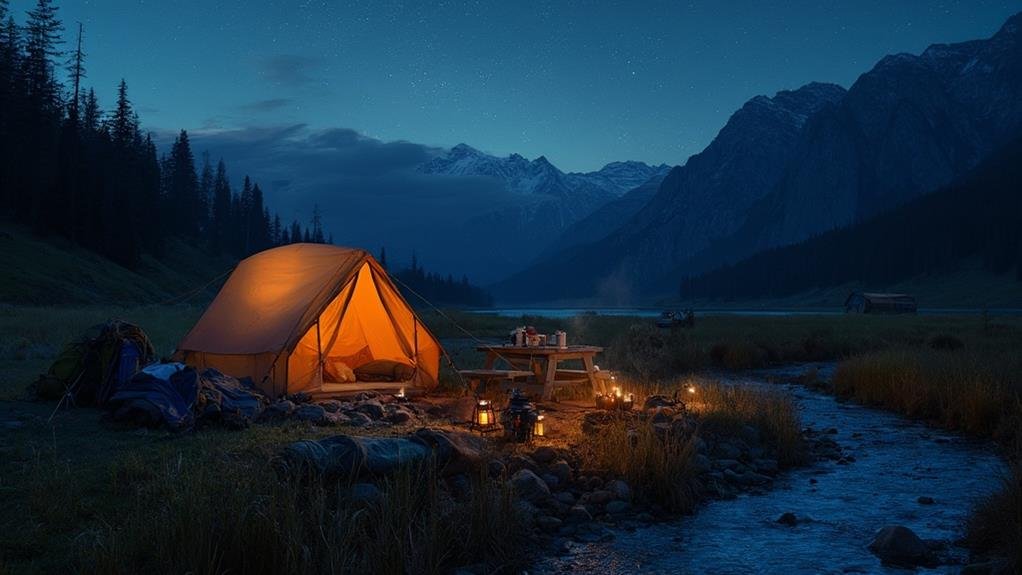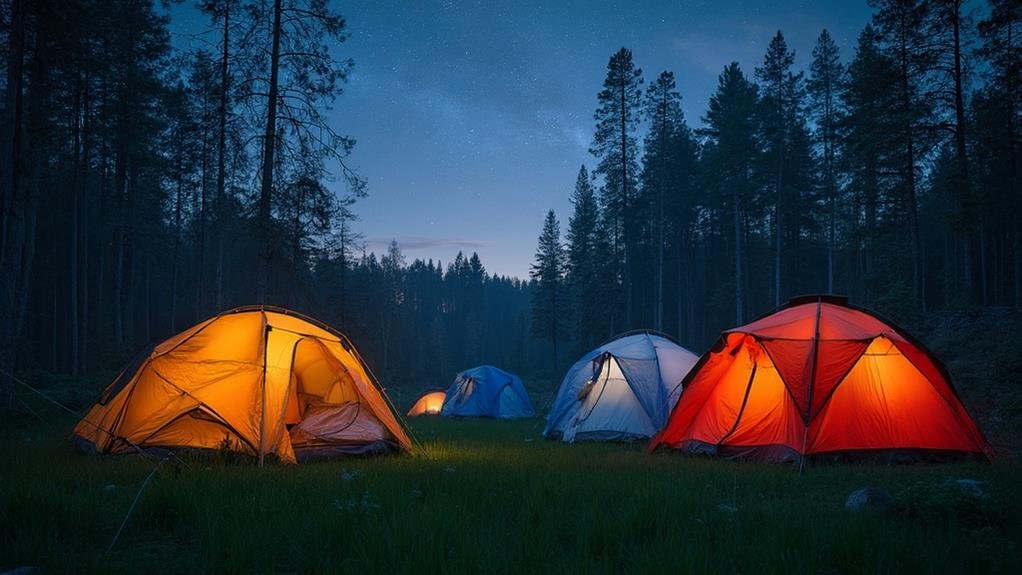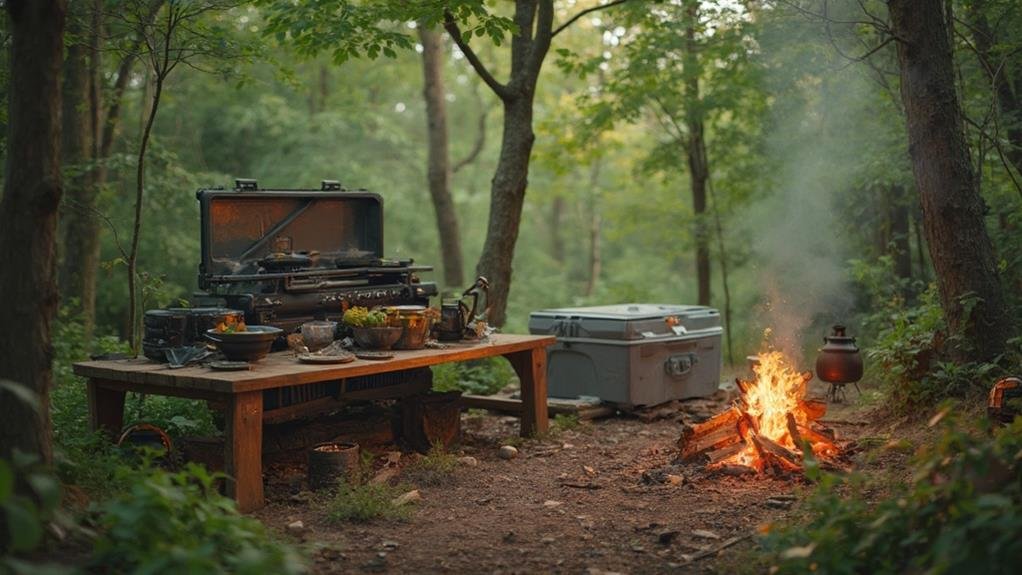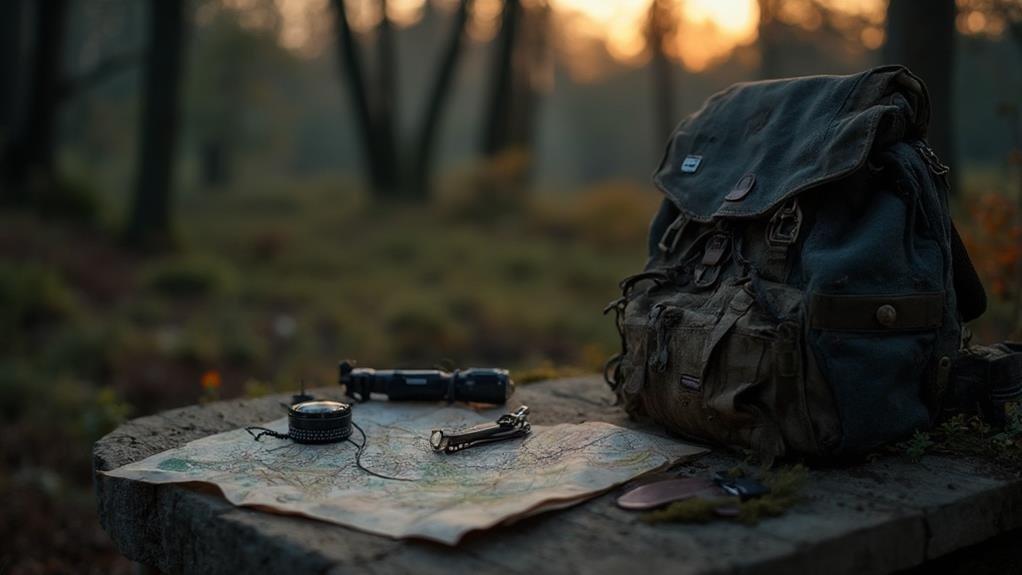

As a first-time camper, you might feel overwhelmed by the sheer variety of gear available, but focusing on the essentials is key. Start with a durable tent that offers protection from the elements—waterproof features are non-negotiable. Pair it with a comfortable sleeping bag and a good sleeping pad to guarantee a restful night. Cooking gear like a portable stove and airtight containers will make meal prep straightforward. Don't overlook clothing; opt for moisture-wicking layers and sturdy footwear. But what about safety and navigation? These components could make or break your camping experience. Let's unpack this further.

Beginning your first camping adventure evokes a sense of excitement and anticipation, and selecting the right tent is an important part of the journey.
You'll want to take into account both the tent materials and tent size to guarantee a comfortable experience. When it comes to materials, think about durability and weather resistance. A tent made from high-quality materials like ripstop nylon or polyester will withstand wind and rain, keeping you safe and dry.
Also, check if the tent has a waterproof coating or a rainfly included, as these features provide extra protection against the elements.
Size is another significant factor to evaluate. You don't want to feel cramped, especially if you're sharing the tent with others. Look for a tent that offers a bit more space than the number of people using it. For instance, if two people are camping, a three-person tent gives you extra room for gear.
It's also important to take into account the tent's height; if you're tall, you might prefer a tent with enough headroom to sit up comfortably.
When you're preparing for your first camping trip, choosing the right sleeping bags and pads is vital for a good night's rest.
You'll want to reflect on insulation types, which can affect how warm you stay. Down insulation is lightweight and compressible, perfect for chilly nights. Synthetic insulation, on the other hand, performs well even when wet, making it a dependable choice for damp conditions.
Sleeping bag shapes also play an important role in comfort and warmth. Mummy-shaped bags are snug and efficient at retaining heat, while rectangular bags offer more room to move. If you're someone who tosses and turns, you might prefer a roomier shape. Contemplate your sleeping habits before making a choice.
Pads add an extra layer of comfort and insulation. Foam pads are durable and affordable, while inflatable pads offer superior comfort with adjustable firmness.
Remember, a good pad can make a significant difference in your overall warmth and comfort.
As you gather your gear, think about your specific needs and the conditions you'll face. With the right sleeping bag and pad, you'll drift off to sleep under the stars, feeling cozy and ready for adventure.

Starting your first camping adventure, it's vital to plan your cooking and food supplies meticulously. Trust me, nothing beats a hot meal under the stars, and having the right gear makes all the difference.
You'll want a reliable portable stove; it's lightweight and easy to use, perfect for boiling water or cooking up some tasty campfire meals. When choosing a stove, consider how many people you're cooking for and how much space you have in your backpack.
Food storage is another significant aspect. You don't want your food spoiling or attracting wildlife, so invest in airtight containers or bear-proof canisters if you're going into bear country.
Plan your meals ahead, choosing non-perishable items like canned goods, dried fruits, and nuts. These aren't only easy to pack but also provide the energy you need for your outdoor adventures.
Always remember to pack enough water or a reliable water filter. Hydration is key, and nothing ruins a trip faster than running out of clean water.
While packing for your first camping trip, don't underestimate the importance of choosing the right clothing and footwear. Dressing appropriately keeps you comfortable and helps you enjoy the outdoors more fully. Here's a simple guide to guarantee you're well-prepared:
1. Layering Techniques: This is key to adapting to changing weather conditions. Start with a moisture-wicking base layer to keep sweat away from your skin.
Add an insulating layer like a fleece or down jacket for warmth, and top it off with a waterproof and windproof outer layer. This way, you can add or remove layers as needed.
2. Moisture Management: Choose clothes made from synthetic or wool materials, as they dry faster than cotton. Quick-drying clothes help you stay warm and prevent chafing.
3. Footwear: Invest in sturdy, waterproof hiking boots with good ankle support. They'll protect your feet from rough terrain and keep them dry.
4. Accessories: Don't forget a hat and gloves for warmth, and a pair of sunglasses for eye protection.

Once you're dressed for adventure, it's time to think about safety and navigation tools to guarantee a successful camping trip. Safety should always come first, and having a well-stocked first aid kit is essential. You never know when a minor cut or scrape might happen, so make certain your kit includes band-aids, antiseptic wipes, tweezers, and any personal medications you might need. Trust me, it's better to be prepared than to wish you were.
When it comes to finding your way around, don't solely rely on your instincts. Bring along a reliable navigation tool. While traditional maps and compasses are great, navigation apps on your smartphone can be a game-changer. Apps like Google Maps or AllTrails offer detailed maps and trails, helping you stay on the right path.
Remember, though, to download maps for offline use since cell service can be spotty in nature.
Also, consider carrying a whistle and a flashlight. A whistle can help you signal for help if needed, while a flashlight guarantees you can see in the dark. With these tools, you'll feel more secure and ready to explore confidently!
Sign up for our newsletter to receive the latest gear reviews, tips, and exclusive offers. Stay informed and inspired for your next outdoor adventure!